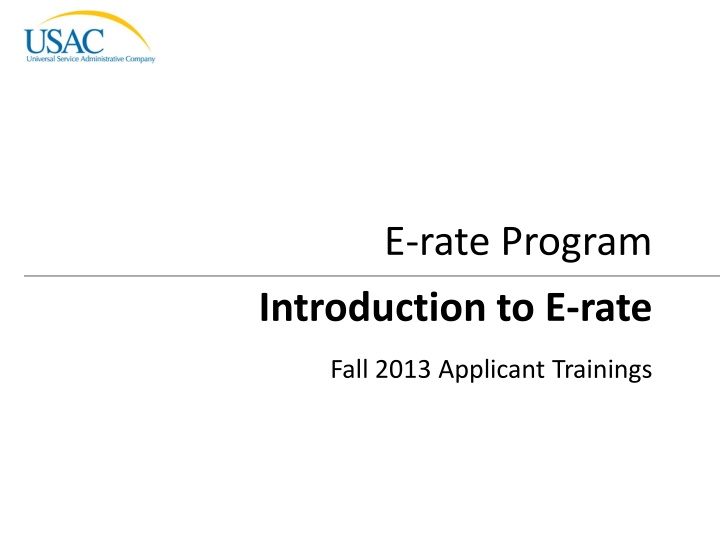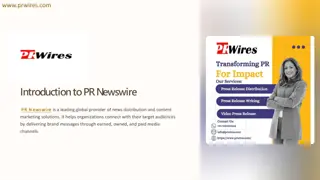
The E-rate Program and Application Process
Gain insights into the E-rate Program, including technology planning, requesting services, competitive bidding, funding commitments, and more. Learn about the background, rules, timeline, budget, and how to navigate the application process effectively.
Download Presentation

Please find below an Image/Link to download the presentation.
The content on the website is provided AS IS for your information and personal use only. It may not be sold, licensed, or shared on other websites without obtaining consent from the author. If you encounter any issues during the download, it is possible that the publisher has removed the file from their server.
You are allowed to download the files provided on this website for personal or commercial use, subject to the condition that they are used lawfully. All files are the property of their respective owners.
The content on the website is provided AS IS for your information and personal use only. It may not be sold, licensed, or shared on other websites without obtaining consent from the author.
E N D
Presentation Transcript
E-rate Program Introduction to E-rate Fall 2013 Applicant Trainings Introduction to E-rate I 2013 Schools and Libraries Fall Applicant Trainings 1
Introduction to E-rate Overview General information about E-rate Technology planning Requesting services (FCC Form 470) Competitive bidding process Ordering services (FCC Form 471) Application review and funding commitments Begin receiving services (FCC Form 486) Invoicing USAC (FCC Form 472 and FCC Form 474) Deadlines Introduction to E-rate I 2013 Schools and Libraries Fall Applicant Trainings 2
Introduction to E-rate General E-rate Information Introduction to E-rate I 2013 Schools and Libraries Fall Applicant Trainings 3
General E-rate Information E-rate Background Federal Communications Commission (FCC), an independent U.S. government agency, established and oversees the E-rate Program. Universal Service Administrative Company (USAC), a not- for-profit, administers the E-rate Program along with three other programs. Schools and Libraries Program (SL) is the part of USAC with responsibility for E-rate. Introduction to E-rate I 2013 Schools and Libraries Fall Applicant Trainings 4
General E-rate Information E-rate Rules Congress directed the FCC to establish the E-rate Program in 1996. The FCC sets rules and policies through orders. USAC develops procedures for specific actions, such as how to process applications. Introduction to E-rate I 2013 Schools and Libraries Fall Applicant Trainings 5
General E-rate Information E-rate Timeline Commitments for E-rate are made by funding year (FY), which runs from July 1 through the following June 30. USAC refers to the funding year as the year in which most services will begin, e.g., FY2013 is July 1, 2013 to June 30, 2014. Introduction to E-rate I 2013 Schools and Libraries Fall Applicant Trainings 6
General E-rate Information E-rate Budget The FCC capped E-rate funding at $2.25 billion per year, until 2010 when the FCC began to adjust the cap annually for inflation Once a year, the FCC is required to roll over all funds that are collected and are unused from prior funding years to the next full funding year Introduction to E-rate I 2013 Schools and Libraries Fall Applicant Trainings 7
General E-rate Information E-rate Eligibility Who is eligible for E-rate funding? Elementary and Secondary schools and school districts Non-traditional facilities (conditionally by state) Libraries and library systems Consortia groups of eligible entities that band together to aggregate demand and negotiate lower prices Introduction to E-rate I 2013 Schools and Libraries Fall Applicant Trainings 8
General E-rate Information E-rate Discounts How large are the discounts on eligible products and services? Discounts are 20-90 percent of eligible costs. Discount level for a school or library depends on: Percentage of students who are eligible for National School Lunch Program (NSLP) in (for a school) the school (for a library) the school district in which the library is located. Urban or rural location of the school or library. Introduction to E-rate I 2013 Schools and Libraries Fall Applicant Trainings 9
General E-rate Information Discount Matrix INCOME URBAN LOCATION Discount ...and you re in an URBAN area, your discount will be... 20% RURAL LOCATION Discount ...and you re in a RURAL area, your discount will be... 25% % of students eligible for NSLP If the % eligible is... Less than 1% 1% to 19% 40% 50% 20% to 34% 50% 60% 35% to 49% 60% 70% 50% to 74% 80% 80% 75% to 100% 90% 90% Introduction to E-rate I 2013 Schools and Libraries Fall Applicant Trainings 10
General E-rate Information E-rate Categories of Service Priority 1 (P1): funded first Telecommunications Services Internet Access Telecommunications Priority 2 (P2): funded second and starts with neediest applicants Internal Connections Basic Maintenance of Internal Connections Introduction to E-rate I 2013 Schools and Libraries Fall Applicant Trainings 11
General E-rate Information E-rate Forms How do I file a program form? Three options: File online, certify on paper File online, certify online File on paper, certify on paper USAC encourages you to file online, because online filing speeds processing and reduces errors. Introduction to E-rate I 2013 Schools and Libraries Fall Applicant Trainings 12
General E-rate Information E-rate Letters Each time applicants file a program form, USAC sends you a notification or acknowledgement letter. Letters are color-coded by funding year 2013 Pink Blue Canary 2014 2015 Note: When storing documents, USAC encourages you to separate your program forms and letters by funding year to better organize them. Introduction to E-rate I 2013 Schools and Libraries Fall Applicant Trainings 13
Introduction to E-rate Technology Planning Introduction to E-rate I 2013 Schools and Libraries Fall Applicant Trainings 14
Technology Planning Technology Plans (P2 Services Only) A technology plan must contain the following 4 elements: Goals and strategies for using technology to improve education or library services Needs assessment Staff training Evaluation plan Technology plans must be approved by a USAC-certified Technology Plan Approver (TPA). Introduction to E-rate I 2013 Schools and Libraries Fall Applicant Trainings 15
Introduction to E-rate Requesting Services (FCC Form 470) Introduction to E-rate I 2013 Schools and Libraries Fall Applicant Trainings 16
Requesting Services FCC Form 470 Purpose Opens your competitive bidding process. Notifies potential bidders of the types and quantities of services that you need. Must be posted on the USAC website at least 28 days before filing the FCC Form 471. Note: Request for Proposals (RFPs) or other supplemental documents may be issued in addition to describe specific needs and circumstances. If you issue an RFP (or provide supplemental documents), the RFP, supplemental documents, and FCC Form 470 must be available during the same 28-day period. Introduction to E-rate I 2013 Schools and Libraries Fall Applicant Trainings 17
Requesting Services Acronyms Billed Entity Number (BEN): an identification number assigned by USAC to each school or library building. Personal Identification Number (PIN): a code assigned by USAC to applicants for use in certifying program forms online. Allowable Contract Date (ACD): the date which marks the end of the 28-day waiting period. Introduction to E-rate I 2013 Schools and Libraries Fall Applicant Trainings 18
Requesting Services Response Letter FCC Form 470 Receipt Notification Letter (RNL): a letter issued by USAC to the applicant that summarizes the information provided in the FCC Form 470. If you notice mistakes, use the RNL to make allowable corrections immediately. Introduction to E-rate I 2013 Schools and Libraries Fall Applicant Trainings 19
Introduction to E-rate Competitive Bidding Introduction to E-rate I 2013 Schools and Libraries Fall Applicant Trainings 20
Competitive Bidding Competitive Bidding Requirements No one other than the applicant or an authorized representative of the applicant should prepare, sign or submit the FCC Form 470 or certification. The FCC Form 470 must describe the desired products and services with sufficient specificity to enable interested parties to submit bid responses. All potential bidders must have access to your FCC Form 470, RFP (or other supplemental documents describing the procurement, if you have them). You must evaluate the incoming bids fairly and equally. Introduction to E-rate I 2013 Schools and Libraries Fall Applicant Trainings 21
Competitive Bidding Sample Matrix The price of the eligible products and services must be the most heavily weighted factor in your evaluation of bids Factor Points Available Vendor 1 Vendor 2 Vendor 3 Price of the ELIGIBLE products and services 30 15 30 25 20 20 0 20 Prior experience w/ vendor Prices for ineligible services, products and fees 25 20 15 25 15 0 15 15 Flexible Invoicing: 472 or 474 10 10 8 7 Local or in-state vendor 92 100 65 68 Total Introduction to E-rate I 2013 Schools and Libraries Fall Applicant Trainings 22
Competitive Bidding Competitive Bidding Process After the 28-day waiting period closes, on the 29th day, you can: 1. Evaluate bids received 2. Choose your service provider(s) 3. Sign a contract (if applicable) 4. Submit an FCC Form 471. Introduction to E-rate I 2013 Schools and Libraries Fall Applicant Trainings 23
Introduction to E-rate Ordering Services (FCC Form 471) Introduction to E-rate I 2013 Schools and Libraries Fall Applicant Trainings 24
Ordering Services FCC Form 471 Purpose Identifies the service providers and eligible services you have chosen on funding requests. Identifies the eligible schools and libraries that will receive services. Calculates how much support you seek for the funding year using your discount calculation information. Introduction to E-rate I 2013 Schools and Libraries Fall Applicant Trainings 25
Ordering Services Acronyms and Terms Funding Request Number (FRN): The identification number assigned to each FCC Form 471 Block 5 funding request. Service Provider Identification Number (SPIN): The identification number assigned by USAC to a service provider. Item 21 Attachment (Item 21): A description of services and prices associated with each funding request. Item 21 attachment(s) are part of the FCC Form 471 and are a window filing requirement. Introduction to E-rate I 2013 Schools and Libraries Fall Applicant Trainings 26
Ordering Services Response Letter Receipt Acknowledgment Letter (RAL): a letter issued by USAC to the applicant and the service provider that summarizes the information provided in the FCC Form 471, which you should carefully review. If you notice mistakes, use the RAL to make allowable corrections immediately. Introduction to E-rate I 2013 Schools and Libraries Fall Applicant Trainings 27
Introduction to E-rate Application Review and Funding Commitments Introduction to E-rate I 2013 Schools and Libraries Fall Applicant Trainings 28
Application Review/Commitments PIA and USAC Reviews, FCC Form(s) 471 Program Integrity Assurance (PIA) is the USAC group that reviews and makes funding decisions on program applications: Verifies eligibility of the schools and libraries entities, entity discount levels, and the services requested. Gives you an opportunity to make allowable corrections to your form. In some cases, asks for additional verification of your compliance with program rules. Introduction to E-rate I 2013 Schools and Libraries Fall Applicant Trainings 29
Application Review/Commitments Decision Letter Funding Commitment Decision Letter (FCDL): Following application review, USAC issues this letter to both the applicant and the service provider. It contains decisions on approved or denied funding requests and next steps. Introduction to E-rate I 2013 Schools and Libraries Fall Applicant Trainings 30
Introduction to E-rate Begin Receiving Services (FCC Form 486) Introduction to E-rate I 2013 Schools and Libraries Fall Applicant Trainings 31
Begin Receiving Services FCC Form 486 Purpose Notifies USAC that your eligible services have started or been delivered and invoices for those services can be processed and paid. Provides the name of the TPA that approved your technology plan (if applicable). Reports your status of compliance with Children s Internet Protection Act (CIPA) a law with specific requirements on Internet safety policies. Introduction to E-rate I 2013 Schools and Libraries Fall Applicant Trainings 32
Begin Receiving Services Response Letter FCC Form 486 Notification Letter: a letter issued by USAC to the applicant and service provider after an FCC Form 486 has been processed. Introduction to E-rate I 2013 Schools and Libraries Fall Applicant Trainings 33
Introduction to E-rate Invoicing USAC (FCC Forms 472, 474) Introduction to E-rate I 2013 Schools and Libraries Fall Applicant Trainings 34
Invoicing USAC Requirements Before Invoicing USAC Applicants and service providers receive an FCDL from USAC for the services being invoiced. Applicants must file an FCC Form 486 and receive an FCC 486 Notification Letter. Service providers must file an Service Provider Annual Certification (SPAC) FCC Form 473 each funding year. Introduction to E-rate I 2013 Schools and Libraries Fall Applicant Trainings 35
Invoicing USAC Two Methods of Invoicing 1) Billed Entity Applicant Reimbursement (BEAR) FCC Form 472: filed by applicant after services have been paid in full OR 2) Service Provider Invoice (SPI) FCC Form 474: filed by service provider after the applicant has been billed for the non-discount portion of eligible services. Note: Applicants can choose their method of invoicing; service providers cannot force applicants to use a particular method. Introduction to E-rate I 2013 Schools and Libraries Fall Applicant Trainings 36
Invoicing USAC Response Letters BEAR Notification Letter: a letter issued by USAC to the applicant with a copy to the service provider after a BEAR is processed. Quarterly Disbursement Report: a letter issued to the applicant detailing all invoicing activity (BEARs and SPIs) during the previous quarter. Introduction to E-rate I 2013 Schools and Libraries Fall Applicant Trainings 37
Introduction to E-rate Deadlines Introduction to E-rate I 2013 Schools and Libraries Fall Applicant Trainings 38
Deadlines Application Deadlines Tech Plan - drafted before the competitive bidding process and approved on or before the date when you begin receiving services or at the time you file the FCC Form 486, whichever date is earlier. FCC Form 470 - Posted at least 28 days before the filing of the FCC Form 471, keeping in mind the FCC Form 471 application filing window opening and closing dates. FCC Form 471 and Item 21 Attachment - Received or postmarked no later than 11:59 PM ET on the day of the close of the FCC Form 471 application filing window (exact window dates will be posted on our website). Introduction to E-rate I 2013 Schools and Libraries Fall Applicant Trainings 39
Deadlines More Deadlines FCC Form 486 - Received or postmarked no later than 120 days after the date of the FCDL or the service start date, whichever is later. FCC Form 472/ FCC Form 474 - Received or postmarked no later than 120 days after the date of the FCC Form 486 Notification Letter or the last date that the applicant can receive service from the provider in the funding year at issue, whichever is later. Appeals - Received or postmarked no later than 60 days after the date of USAC's decision letter. Introduction to E-rate I 2013 Schools and Libraries Fall Applicant Trainings 40
Contacts With questions, please contact us! Phone: (888) 203-8100 Fax: (888) 276-8736 Website: www.usac.org/sl Introduction to E-rate I 2013 Schools and Libraries Fall Applicant Trainings 41
Questions? Introduction to E-rate I 2013 Schools and Libraries Fall Applicant Trainings 42





